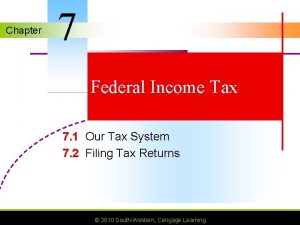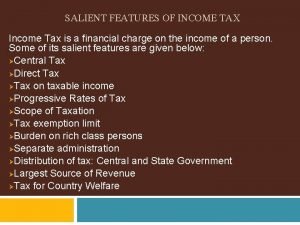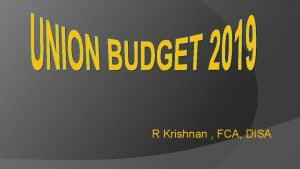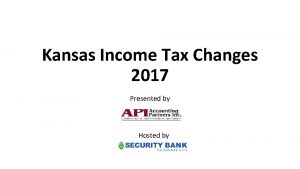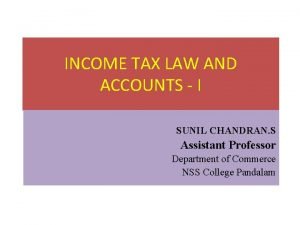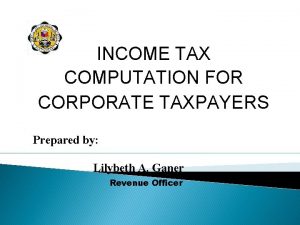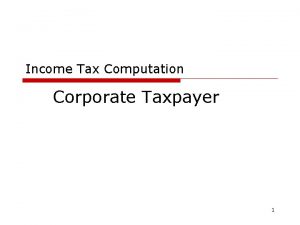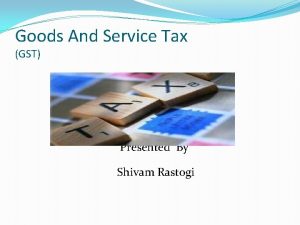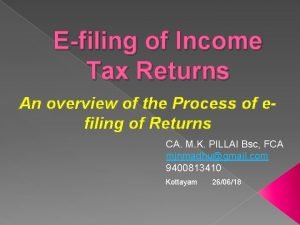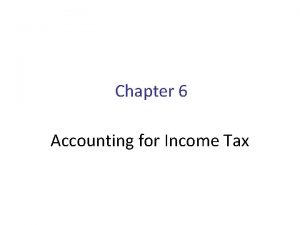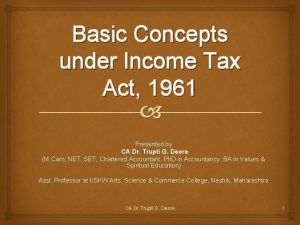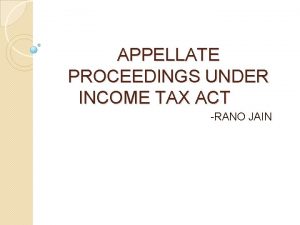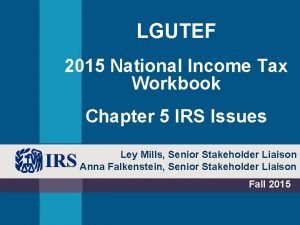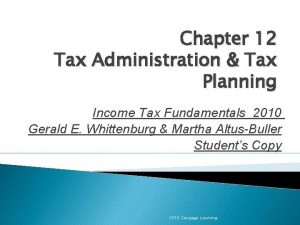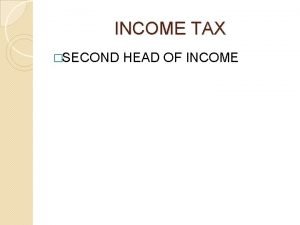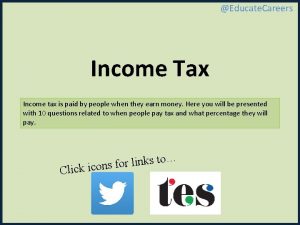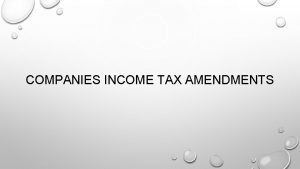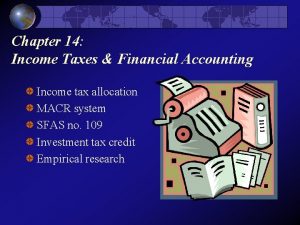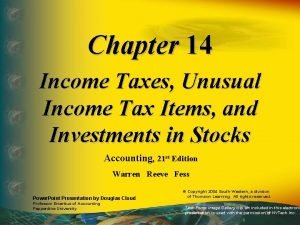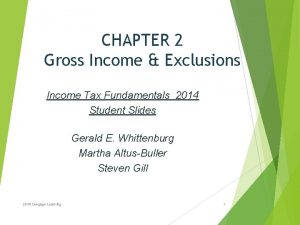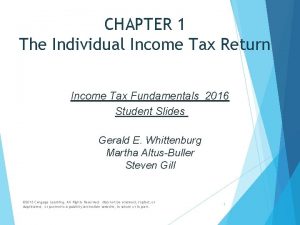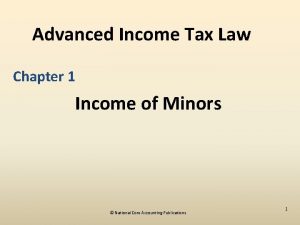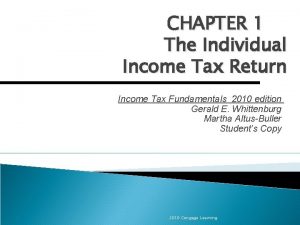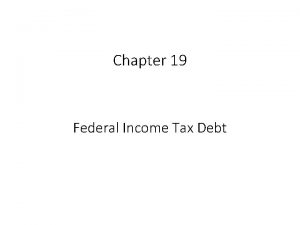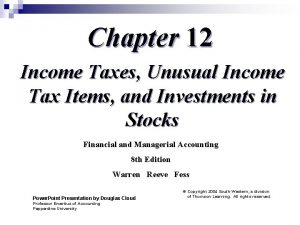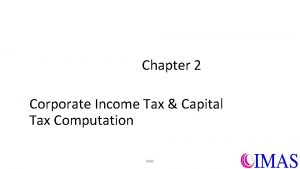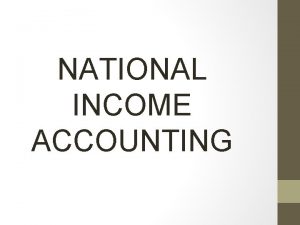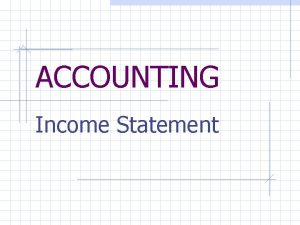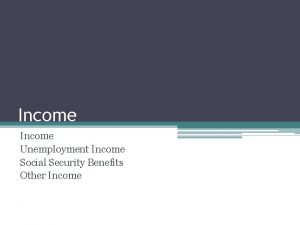Chapter 2 Income Tax Definition of Income Tax

























- Slides: 25

Chapter 2 Income Tax

Definition of Income Tax � The tax imposed on a person or entity under the orbit of Income Tax Law is called income tax. Income tax is a typical example of direct tax. It is imposed on a person in relation to his income. It is calculated and assessed with reference to the income of an assessee for a given year. � Income tax ordinance 1984, that is currently in operation in Bangladesh does not directly define income tax.

� Analysis of section 16 of the Ordinance provides some indications to this end. It provides that Income Tax is one which is imposed, charged, payable and collected in relation to the income of a person for Income year or years on the basis of tax rate of the assessment year. � Finally, Income tax is direct tax that is charged on the total income of a person for relevant income year.

Characteristics of Income Tax � It is a direct tax � It is charged on the total income of a person � It is charged on the income of the income. year at the rate applicable in assessment year. � It is payable in the year following the income year � It is generally charged on revenue income of a person.

Basic Terminology of Income Tax � Income Year The year of the income for which tax is levied is called Income Year or Income year is the year in which income was earned. In the income tax Act of 1922, it was called the Previous Year. According to section 2 (35) of Income Tax Ordinance, 1984, income year means the Financial Year (i. e. the year commencing in 1 st July every year) immediately preceding the assessment year or any other accounting period (not exceeding twelve month )as adopted by the assessee and ending within the said financial year.

Importance of income Year 1. 2. 3. 4. Computation of total income: An assessee has to pay tax on total income earned in the income year. Income earned in the previous year or subsequent year will not be considered to compute total income of an income year. Investment Allowance: An assessee will avail tax credit facilities for an income year only on the amount invested in that income year. Residual Status: Residential status of an assessee is determined on the basis of his stay in the income year, not in the assessment year. Submission of Accounts: The date of submitting the accounts of an assessee is determined on the basis of income year.

Ø Assessment Year: Assessment year means the period of twelve months commencing on the first day of July every year. Thus, the assessment year always begins on 1 st July and ends on 30 th June every year. Importance of Assessment Year � Computation of Tax Liability: The tax liability of an income year is computed on the basis of rates applicable in the assessment year. � Tax exemption and tax credit facilities: Tax exemption and tax credit facilities are to be considered on the basis of provisions applicable for an assessment year.

Identification of Income year and Assessment Year 1. If the financial year of an assessee ends within 30 th June, the said financial year will be his income year and the subsequent year (period covering July 01 to June 30) will be the assessment year. For example, if the financial year of an assessee ends on June 30, 2009, the income year will be 2008 -09 and the assessment year will be 2009 -10. 2. If the financial year of an assessee ends after 30 th June, his income year will be the next financial year and assessment year will be subsequent year of the income year. � For example, if the twelve months period of financial year of an assassee ends on July 31, 2008; August 31 , 2008, September 31, 2008; October 31, 2008, November 31, 2008 etc. the income year will be 2008 -09, as the ending date of the financial year has not fallen before 30 th June of the financial year 2007 -08. As a consequences, the assessment year will be 2009 -10.

3. If the financial year of an assessee ends as per the calendar year i. e. on December 31; the same procedure explained in above will be applicable in determining the income year and assessment year. 4. In case of a newly established business the duration of the first income year may be less than 12 months. But it will be 12 months from the subsequent income years. It may also be considered as 12 months as per the assessee’s requirement. For example, if a business has started on 1 st January 2009; 1 st February 2009; 1 st March 2009 etc. the income year will be 2008 -09 and the assessment year will be 2009 -2010.

Determine the income year and assessment year for the following independent situations: i. Nitol motors close its accounting record on 15 th April, 2008 for the year. It maintains its accounts as per that date. ii. Uttara Limited started its business on September 01, 2008. iii. Venture Properties Limited started its business on October 01, 2008 and its first accounting year ended on 31 st March 2009. The company will maintain its accounting records as per this date every year. iv. Pran Ltd. started its new business on 31 st July, 2008. It will follow the calendar year as its accounting year.

Definition of Assessee is a person who is liable to pay any sum under the Income Tax Ordinance, 1984. Here, the term person includes an individual, a firm, an association of persons, a hindu undivided family, a local authority, a company and every other artificial judicial person. Classification of Assessee: From the point of view of residence, assessee is classified into two: a. Resident b. Non resident An individual whether resident or non resident depends mainly on the duration of his stay in Bangladesh. On the other hand for a firm and a company , whether resident or non resident depends on the location of its management or control during the relevant income year

Methods of Determining Residential Status: 1. An Individual: To be a assessee, an individual must fulfill one of the following conditions: a. If he stays in the country for a period of at least 182 days during the income year, or b. If he stays in the country for at least 90 days during the income year and also had been in the country for a period of at least 365 days during four years preceding the income year. � Under Section 2 (44), if an assessee fails to fulfill any one of the above two conditions becomes nonresident for that particular year.

2. Company: To be a resident a company should fulfill one of the following conditions: a) It should be registered under the Company Act, 1994. b) In the case of other companies they will be treated as residents if the control and management of their affairs are situated wholly in Bangladesh. On the other hand, if the control and management of a company is situated partly or wholly outside Bangladesh, it will be considered as nonresident.

Tax Rates/Tax Slabs Tax liability of an assessee is determined at the rate or rates applicable on the total income of the assessee. The rate of tax is not uniform for all types of assessee and for any level of income. So it is important to know the rate of rates applicable for different types of a assessees in different assessment year. Tax rate for individual, Hindu undivided family, firm, association of persons or artificial person created by law. 14

Tax Rates/Tax Slabs (Cont…) General tax rate for the Individual, Hindu Undivided Family, Firm and Association of Person (20152016) SL. No. Income Level/ Slabs Applicable Tax Rates 1. On first TK. 2, 50, 000 Nil 2. On next TK. 4, 000 10% 3. On next TK. 5, 000 15% 4. On next TK. 6, 000 20% 5. On next TK. 30, 000 25% 6. On next Balance 30% 15

Tax Rates/Tax Slabs (Cont…) Tax rate for women and senior citizen (65 years and above), (2015 -2016) SL. No. Income Level/ Slabs Applicable Tax Rates 1. On first TK. 3, 000 Nil 2. On next TK. 4, 000 10% 3. On next TK. 5, 000 15% 4. On next TK. 6, 000 20% 5. On next TK. 30, 000 25% 6. On next Balance 30% 16

Tax Holiday Schemes A Tax Holiday is a temporary reduction or elimination of a tax. It is synonymous with tax abatement, tax subsidiary , or tax reduction. Tax Holiday Scheme means the period for which the tax is exempted for the particular firm or industry. Governments usually create tax holidays as incentives for business investment. Tax holidays have been granted by governments at national, sub-national , and local levels, and have included income, property, sales, VAT, and other taxes. Some tax holidays are extra-statutory concessions, where governing bodies grant a reduction in tax that is not necessarily authorized within the law. In developing countries , governments sometimes reduce or eliminate corporate taxes for the purpose of attracting foreign direct investment or stimulating growth in selected industries. 17

Tax Holiday Schemes (Cont…) The objectives of tax holiday scheme are as follows: q To encourage formation of domestic capital needed for rapid industrialization of the country. q To attract direct foreign investment in the desired industrial sectors of the economy. q To maintain sectored balance in industry. q To have a balanced and equitable development of all the areas of the country. 18

Taxpayer’s Identification Number (TIN) The provision relevant to issue & use of TIN was introduction by the Finance Act, 1993 & made applicable from 1 st July, 1994. According to this provision a tax payee need to apply to tax authority in a prescribed form to get his TIN and the authority will issue the same as soon possible. Finance Act 2011 provides that hence forth fee Tk. 1, 000 will not be required to get TIN. Further, TIN may be issued by tax authority if a person is found to have taxable income during income year, without application received from that person. This number is required to be used by the assessee in his tax return & in case of getting other documents and other matters. 19

12 digit TIN Finance Act 2014 has made 12 Digit number TIN compulsory. To this end following provisions of getting 12 Digit TIN have been made: i. It will be issued by NBR on application made by assessee. If assessee does not apply but Tax authorities have required information, authority can issue 12 digit Tin to assessee. ii. Assessees who have earlier TIN registration, the NBR on such a case by issuing special direction can collect information and issue 12 digit TIN. iii. Assessees who have earlier 10 digit TIN are require to collect 12 digit TIN before submission of tax return.

Taxpayer’s Identification Number (TIN) (Cont. . ) Requirement of TIN in different cases: ü Renewal of trade licence in the area of a city corporation or of a Pourashava of a divisional headquarters or of a district headquarters. ü Opening a letter of credit for the purpose of import ü Issuance or renewal of license or enlistment of a surveyor of general insurance. ü Issue of credit card ü Giving ISD connection to any kinds of telephone. ü Renewal of membership of any trade body. ü Registration , change of ownership or renewal of fitness of a bus , truck, Prime mover, lorry etc, plying for hire. 21

Tax credit � A tax credit is an amount of money a taxpayer is able to subtract from taxes owed to the government. Tax Exemption � Tax exemption come in many forms, but one thing they all have in common is they either reduce or entirely eliminate your obligation to pay tax. Tax Refund: A tax refund is the difference between taxes paid and taxes owed. Tax Return: Tax Return is a statement of your earnings, tax liability, details of tax paid any refunds that has to be given to the government.

�Tax Evasion Tax evasion is an illegal practice where a person, organization or corporation intentionally avoids paying his true tax liability. Tax evasion applies to both the illegal nonpayment as well as the illegal underpayment of taxes. Tax evasion activities include: a. Underreporting income b. Inflating deductions or expenses c. Hiding money

�Tax Avoidance Tax avoidance is the use of legal methods to modify an individual's financial situation to lower the amount of income tax owed. This is generally accomplished by claiming the permissible deductions and credits. This practice differs from tax evasion, which uses illegal methods, such as underreporting income to avoid paying taxes. charitable contributions are taxdeductible and thus another way that taxpayers can lower their tax bills

Differences between Tax evasion and Tax avoidance
 Chapter 7 federal income tax
Chapter 7 federal income tax Gdp per capita formula
Gdp per capita formula Carrying amount formula
Carrying amount formula Comprehensive income tax
Comprehensive income tax Deferred tax asset journal entry
Deferred tax asset journal entry How to file income tax return in winman software
How to file income tax return in winman software Movable assets
Movable assets Salient features of income tax act 1961
Salient features of income tax act 1961 195 of income tax act
195 of income tax act Kansas income tax rates
Kansas income tax rates Perquisites in income tax
Perquisites in income tax Individual tax computation format
Individual tax computation format Income tax computation format
Income tax computation format James wilson income tax
James wilson income tax Federal income tax calculation
Federal income tax calculation Efilingofincometax
Efilingofincometax Easy office download
Easy office download Income tax expense
Income tax expense Income tax meaning
Income tax meaning Income tax meaning
Income tax meaning Form 35 income tax
Form 35 income tax Chapter 19 intermediate accounting
Chapter 19 intermediate accounting National income tax workbook
National income tax workbook Maksud pengiktirafan hasil
Maksud pengiktirafan hasil Citizen and resident
Citizen and resident Income tax in russia
Income tax in russia
